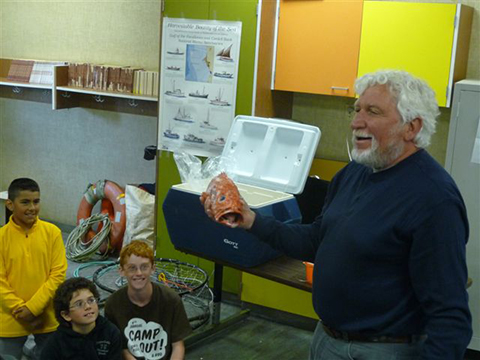At your School

Connect your students with the wonder of the ocean. Our At Your School programs bring exciting hands-on ocean science to your classroom. Led by our team of marine science educators, our programs bring to life diverse topics such as Crabs (K-3rd), Seabirds (3rd-5th), Sharks (4th-6th), Otters & Ocean Germs (5th-7th), Ocean Acidification (7th-12th), Fisherman in the Classroom (7th-12th) and Deep Sea Corals (9th-12th). All programs are aligned with Next Generation Science Standards. Fees apply. Scholarships are available.
Crab Cab (K-3)
Call the Crab Cab for your kindergarten, 1st, 2nd or 3rd grade class and we'll bring the learning right to your door! The Crab Cab is a fun, interactive, 45-minute classroom program where students learn about crabs, crab diversity and good seashore manners. Activities include a crab dress-up and observations of live crabs. Hail the Crab Cab for your school today!
Seabird Shuttle (3-5)
Students will learn about local seabirds, investigate adaptations using artifacts and discover the fascinating life cycle of a common murre by playing a life-size "chutes n' ladders" game in this 60-minute program. The instructor will lead a discussion on ways that your students can have a positive effect on the ocean and its ecosystems.
Sharkmobile (4-6)
Bring the Sharkmobile outreach program on shark biology and conservation to your 4th, 5th or 6th grade class. This exciting 60-minute classroom program explores the biology and natural history of sharks from around the world through shark artifacts and film. Students will discuss shark myths and observe real footage of white shark research at the Farallon Islands.
Otters & Ocean Germs (5th-7th)
Bring the biology of pathogens and how they affect marine mammals to your 5th, 6th, or 7th grade class! Students will learn about sea otter biology and ecology, the importance of coastal wetland restoration and how pathogens affect all marine mammals. Through interactive games, activities and specimens this 50-90 minute program will engage your class in fascinating germy science!
Ocean Acidification: A Sea of Change (7th-12th)
Students will observe live plankton samples and learn how increasing acidity affects ocean food webs and larval stages of organisms. Through demonstrations and experiments, this 50-90 minute program will introduce your class to the process behind the changing chemistry and biology of the earth's oceans.
Fisherman In the Classroom (7th-12th)
The Fisherman In the Classroom Program brings local commercial fishermen into Bay Area classrooms to teach students about the rich cultural history and current day relevance of commercial fishing in Central California. Through games, slide shows and props such as crab traps, Humboldt squid and live Dungeness crabs; fishermen and sanctuary educators collaborate to deliver a lively and interdisciplinary 90-minute program that brings to life subjects as diverse as biology, economics, social science and oceanography. Besides putting a human face on important issues such as sustainable fisheries, climate change, watershed restoration and marine sanctuaries, students learn how humans impact the ocean from a knowledgeable ocean expert with a unique perspective.
For more information or to schedule a program, contact Peter Winch at (415) 530-5352 or pwinch@farallones.org. Fees apply.
Deep Sea Corals (9th-12th)
In this 60-minute program, students will work in groups to evaluate biodiversity found in deep sea habitats of Greater Farallones National Marine Sanctuary using research videos taken from Remotely Operated Vehicles (ROVs). With training from a marine science educator, students will learn the techniques and challenges behind deep sea research and will be trained on species identification and habitat characterization. Students will learn how to estimate species abundance and diversity by viewing real ROV footage and recording, analyzing and graphing scientific data. This program can also be extended into a multi-day program that explores and compares data between numerous west coast national marine sanctuaries.

